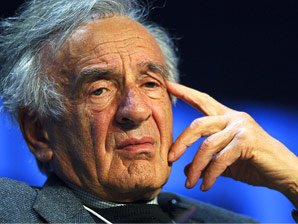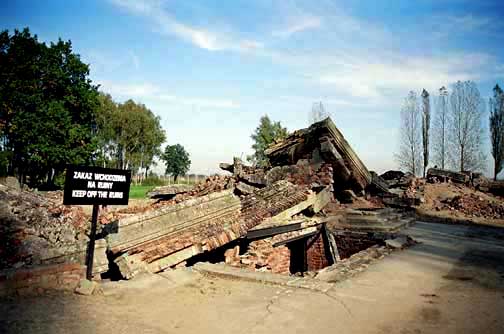Blog
Video
Written on June 7, 2012 at 1:45 pm, by admin
Elie Wiesel Cons The World from AirNSwordz on Vimeo.
Elie Wiesel sponsors petition that assaults Greek and European democratic independence
Written on May 31, 2012 at 3:53 pm, by Carolyn
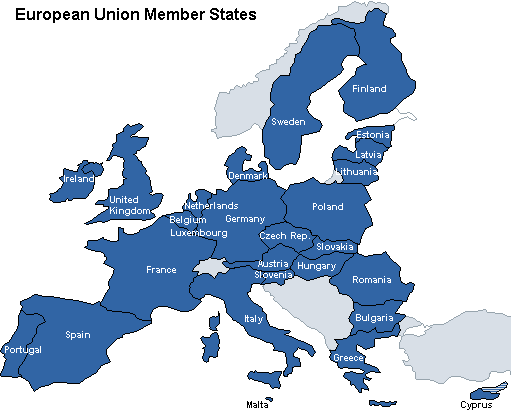 Europe (above) should be wide open to all comers, according to Elie Wiesel, EGAM (European Grassroots Antiracist Movement) and SOS-Racisme.org.
Europe (above) should be wide open to all comers, according to Elie Wiesel, EGAM (European Grassroots Antiracist Movement) and SOS-Racisme.org.
By Carolyn Yeager
(last edited on June 1st)
Elie Wiesel wants you to sign a petition that proclaims “We are all Greek Jews. ” It in essence will mean that you approve that Greek voters (and voters in every other European nation) must comply with the wishes of the Jewish community in their nation when it comes to their political choices. This is such insanity that the world media are not even carrying the story. The Guardian was chosen to publish the petition as a news story, but it has not spread very far.
Elie Wiesel, however, is one of the original signatories, lending whatever prestige he may still possess to the misbegotten venture. The other signers are mostly Jewish, with a possible smattering of water-carriers and communists. The sponsors include two antiracist organizations: EGAM and SOS Racisme. What do they want? They want to destroy Europe as a white homeland. Can anyone really think this is a good idea?
Voice of conscience
Organized Jewry presents itself as the voice of conscience of the world. This has long been a favored method of control and, though there is no basis for it, many white European peoples, because of the constant media barrage portraying Jews as “wise and carriers of the West’s oldest religion,” seem to fall for it. The Jew-controlled mass media is the new “Holy Scripture” that gives us our modern morality of Tolerance as the highest virture and Equality as the highest law.
The main intention of Elie Wiesel and the other signatories is to enforce “The Holocaust” as the world’s religion for the goyim … as they term all non-Jews. For the same reasons they seek to make the world accept Jerusalem as the supreme seat of international justice, from whence the final decisions on all matters—for which there will be no appeal—will flow. We are to view the world through Jewish eyes and only through Jewish eyes. The very first paragraph of the petition tells us this.
The neo-Nazi party Golden Dawn entered the Greek parliament this month. With its swastika-inspired emblem, Hitlerian salute, reference to Mein Kampf, antisemitic and racist ideology, Holocaust denial, violence against migrants, threats against journalists and personality cult, the party is the lineal heir of the German national-socialist party that led Europe and the world into chaos and bloodshed.
Who else but Jews would write this? But it is incorrect — it was not the German National-Socialist party that led Europe and the world into chaos and bloodshed. It was in actuality World Jewry! The petition then goes on to add Latvia, Austria, and Hungary to Greece for the crime of “Third Reich nostalgia,” simply because a segment of their populations voted for anti-immigration parties considered to be on the “right.” Finally, it accuses Geert Wilders Freedom Party in The Netherlands of promoting “race inequality” because it is against so many Muslims in the country changing the culture from Dutch to middle-eastern.
The petition signatories hate nationalism and favor regional unions (like the EU) and an over-arching world government because they think they have a better chance of manipulating the latter to their purposes. They use the word “terrifying” to describe trends toward nationalism, implying that Greek Jews (a tiny minority in Greece who make far more noise than their numbers warrant) are in danger of extermination!
We refuse to accept that on our continent, Jewish, immigrant, Muslim, Roma or black people might fear for their lives because of who they are. We invite all citizens, political parties, unions, civil society, intellectuals and artists to fight the extreme right by promoting and bringing to life the European dream. We must always remember that this dream was built on the ruins of Nazism. We must never forget about the Shoah. Our dream is of a continent free from racism and antisemitism. It is the project of a society based on “togetherness” – beyond boundaries.
Incredible assumptions. Their continent? Europe is not the Jews’ homeland, nor is it the homeland of Muslim, Roma or black people. It is the homeland of white Caucasian, Indo-Aryan people. It is these white Caucasian people who are now fearing for their lives! Europe does have boundaries, and those boundaries are important. It is clear that these signatories, which include Elie Wiesel, want to exert their own very un-European ideas on Europe. When Europeans begin to resist this alien takeover and the imposition of the “Holocaust” religion, these Jews naturally get very nervous. They over-react, as they’re doing now.
Recommended Dogmas
They go so far as to propose two shockingly blatant “dogmas” for Europeans — as if the World International Court in Jerusalem were already a reality.
- Refute austerity (a slam at Germany), because it puts the bankers (Jewish capitalism) out of their profits from eternally increasing debt (a ponzi scheme).
- Refute the anti-immigration “lockdown” of Europe’s frontiers, because the social welfare system requires constant immigration to sustain itself.
They insist on democracy, social justice and the promotion of equality. They mean by this that blacks, gypsies (who are not indigenous to Europe but came from India), Asians, Arabs and Jews must be considered equal to the national population simply by putting their feet on that national soil. They must be given social equality, meaning special financial and other assistance that will afford them a comparable lifestyle to the working native population. In this way, the illusion can be created that everyone is equal. See Germans to Learn Turkish … instead of Turks learning German, for the shape of things to come if Elie Wiesel has his way.
Why not “We are all Palestinians now”
One naturally has the thought: Why aren’t these Jewish petitioners compiling something to send to Israel titled “We are all Palestinians now.” Why isn’t equality desirable in Israel? The inequality in Palestine under Jewish rule is far, far, far worse than anything found in Europe. Ditto the anti-immigration feeling. What we have here is the same old hypocrisy that Elie Wiesel has been exhibiting his entire life.
These petition signers know that forced equality is unnatural and will weaken, even sicken, the host population. So for them, Europe belongs to everyone. But Israel belongs to the Jews.
Don’t sign the petition, and in fact mock and ridicule anyone who does. They deserve it.
Elie Wiesel adds a new twist to his Buchenwald liberation tale
Written on May 19, 2012 at 9:18 am, by Carolyn
by Carolyn Yeager
To cry or not to cry, that is the question.
Elie Wiesel, as usual, cannot make up his mind.
On May 6, he gave a major speech (for big bucks) at Xavier University in Cincinnati, brought there by the Center for Holocaust and Humanity Education. A reporter who covered the speech wrote that Wiesel said this:
Wiesel recounted his rescue from the concentration camp by the U.S. Army and said he remains grateful.
“We cried,” he recalled. “We discovered for the first time that we could cry.”
But in an interview that was published on the following day, May 7, on NBC New York, Wiesel said the opposite to reporter Gabe Pressman:
He told me about the day the American army came to liberate the prisoners,
How the prisoners “wanted to cry but they didn’t know how to cry… if you cry, you will never stop so they didn’t even do that.”
So which is it? Did they cry or didn’t they? It seems you get to choose which version you like best.
I pointed out in this article on the Xavier speech that this was the first time I had ever heard or read Elie Wiesel say that he or his barracks-mates cried. Since this Blog takes the position that Wiesel was not even there (in Buchenwald), it’s kind of a mute point–except for the fact that it’s one more reason not to believe he was there. He can’t keep his “story” about it straight.
Wiesel embellished his Buchenwald liberation tale when he was interviewed by Oprah Winfrey, too. As I recounted in this article, he told Oprah in Nov. 2000 that the first thing the religious boys in his barracks did was to “reassemble” and offer prayers for the dead–yet in his books he made a point to say the only thing anyone did was go after the food provisions. He wrote that they had no thought of their families nor of friends, only of food.
The flexibility of memory
Considering all this, we arrive at a crucial question about the Holocaust. The fate of nations may hang on it! What does it mean if Memory, that sacred human ability on which the entire holocaust narrative rests, cannot be depended upon?
Elie Wiesel’s memory is clearly not reliable. Yet he himself has made everything depend on memory. He wrote: “I shall never forget that night, the first night in camp […] never shall I forget those moments … ” and so on. But he must have forgotten some things since his story doesn’t remain consistent.
Memory itself–the act of remembrance–is just not what Elie Wiesel makes it out to be. For Weisel, it’s more like these words he is famous for saying: Some things are true though they didn’t happen, while others are not, even if they did. That is how we tend to remember!
In his case, Elie Wiesel was liberated from Buchenwald, even if he wasn’t … and it’s not true that the prisoners were only interested in food, even if they were. Memory–it’s such a flexible thing.
Elie Wiesel Knows Soviet “Liberators” Destroyed the Birkenau Crematoriums
Written on May 10, 2012 at 9:35 am, by Carolyn
By Carolyn Yeager
copyright 2012 carolyn yeager
The official Holocaust narrative versus Elie Wiesel on what is Auschwitz Liberation Day
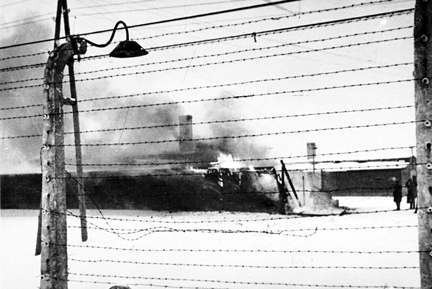 The official Holocaust narrative has it that the Red Army did not arrive at the Auschwitz labor camps until January 27th, 1945—where they found some of the barracks burning, and also blown-up crematorium buildings which had housed “gas chambers.” This is the date that is commemorated all over the world as the Liberation of Auschwitz.
The official Holocaust narrative has it that the Red Army did not arrive at the Auschwitz labor camps until January 27th, 1945—where they found some of the barracks burning, and also blown-up crematorium buildings which had housed “gas chambers.” This is the date that is commemorated all over the world as the Liberation of Auschwitz.
However, on page 87 of the novel Night it is stated that the Russians “liberated” the inmates who were left behind at Monowitz (Auschwitz III) on January 20th, two days after the bulk of the prisoners left on the one-day forced march to Gleiwitz, from where they were put on a train to Buchenwald.
______________________
The photograph at right is a still photo from a Soviet propaganda film about the Auschwitz liberation. The clothing warehouses, known as “Canada,” are burning. But who set them on fire? [Author’s note: In January 2014, I wrote in an article published here: The photograph at right, a still from a Soviet propaganda film about the Auschwitz “liberation,” had been thought to be of the clothing warehouses burning. But new research suggests it is more likely regular barracks, probably in Compound B1. If this is true, it makes little difference when the picture was taken, as it was certainly after the Russians arrived.]
___________________________________________________________________________________
I included this detail in Night #1 and Night #2, Part Two under the heading “A record of fact it isn’t.” For the first time I’ve seen anywhere, I pointed out this sentence from Elie Wiesel’s book Night:
A strange detail … is on page 87 of the original Night. Eliezer remarks, after his and his Father’s deliberations and final decision to go on the march: “I learned after the war the fate of those who had stayed behind in the hospital. They were quite simply liberated by the Russians two days after the evacuation.” The evacuation, as we all know, was on the 18th. We also know the Russians did not arrive on the 20th of January! The actual liberation day is January 27. What possessed Wiesel to write this? Well, because it was in Un di velt: “Two days after we had left Buna, the Red Army occupied the camp. All the sick had stayed alive.”
It’s important to keep in mind that the Jan. 20th liberation originally appeared in Un di velt hot geshvign, the Yiddish book published in 1955 from which La Nuit was born in 1958 (with the English version Night following in 1960). Whether or not Elie Wiesel is the author of the Yiddish book, there is no doubt that he wrote La Nuit directly from it. So he either wrote that sentence in Un di velt or he copied it from Un di velt for La Nuit. In any event, he has never rejected that sentence as a mistake, nor was it changed in Marion Wiesel’s 2006 translation … perhaps because it appears in the Yiddish Un di velt.
What is the official narrative and what is its source?
There is no easily determined source for the narrative. It consists of the story that the Germans returned to Birkenau on Jan. 20th to blow up Crematorium II and III in order to destroy the evidence of the “gas chambers.”
According to web-based Holocaust Research Project:
On 20 January 1945 an SS division under SS–Corporal Perschel destroys Crematorium II and III and abandons the camp. On 26 January an SS squad blows up Crematorium V, the last of the crematoriums in Birkenau.
An entire division was required to explode two measly crematorium buildings?! I guess what they’re trying to say is that an SS team returned to Birkenau, after the bulk of the prisoners had been evacuated and before the Russians first arrived, to destroy the “evidence.” In other words, they didn’t plan well enough to do it ahead of time so had to sneak back after they had already abandoned the camp. But wouldn’t the ex-prisoners who remained in the hospital buildings that were very close to Crema II and III have heard and seen the explosions? Yes, of course they would, although we don’t have any statements of hospital patients about a demolition in the camp on January 20th.
On Nizkor we find this timetable (source unknown):
“January 20 [1945] … The SS division under Corporal Perschel blows up the already partly demolished Crematoriums II and III and abandons the camp.”
“January 23 [1945] … An SS division arrives in the prisoner’s infirmary camp in B-IIf in the afternoon…they set 30 storeroom barracks [the “warehouses”-cy] in the personal effects camp on fire…. These barracks burn for several days. After the liberation, 1,185,345 pieces of women’s and men’s outerwear, 43,255 pairs of shoes, 13,694 carpets, and a large number of toothbrushes, shaving brushes, and other items such as protheses, glasses, etc., among other things are found in the six remaining partially burned barracks.” [Note: The warehouse barracks were right behind the hospital barracks, where most of the remaining prisoners were staying.]
“January 26 [1945] … At 1:00 A.M. the SS squad with the task of eliminating the traces of SS crimes blows up Crematorium V, the last of the crematoriums in Birkenau.”
“January 27 [1945] …The first Red Army reconnaissance troops arrive in Birkenau and Auschwitz at around 3:00 P.M. and are joyfully greeted by the liberated prisoners….
[Note: If the clothing warehouses were set on fire on Jan. 23, would they still be burning on Jan. 28, 29, 30… however long it took the Soviet movie makers to get there?-cy]
 Above: Underneath the roof of the dynamited Crema II in 2005. Below: Ruins of Crema III taken at the same time (Photos courtesy of Scrapbookpages.com)
Above: Underneath the roof of the dynamited Crema II in 2005. Below: Ruins of Crema III taken at the same time (Photos courtesy of Scrapbookpages.com)
In Danuta Czech’s Calendarium [Auschwitz Chronicle 1939-1945, Henry Holt, 1990, 855 pp], probably the source of the above, Czech has the final destruction of Cremas II and III taking place on January 20, 1945. Her basis for that are two “eyewitnesses”—female prisoners Anna Kowalczyk and Maria Matlak—who had remained behind and who said that they “saw” the SS in the camp on that day, and from them came the name of SS-Unterscharführer Perschel, who had been “capo of the Work Service in the women’s camp”, so they knew him. These two women said that after ordering 200 women outside the camp gates to be shot (!), Perschel selects a group of male prisoners from the infirmary (!) to carry boxes of dynamite to Cremas II and III. This is the entire basis for Czech’s claim that the SS returned on Jan. 20th and blew up the Cremas! This is what the Holocaust Industry passes off as proof.
The United States Holocaust Memorial Museum uses Czech’s timeline, but leaves out the Jan. 20-26 demolition dates.
USHMM’s Chronology of the Holocaust
JANUARY 17, 1945
As Soviet troops approached, SS units evacuated prisoners in the Auschwitz camp complex, marching them on foot toward the interior of the German Reich. The forced evacuations came to be called “death marches.”
JANUARY 27, 1945
Soviet troops liberated about 8,000 prisoners left behind at the Auschwitz camp complex.
I did not find anything on the Auschwitz-Birkenau website either. So one thing is clear: these dates about the SS divisions returning to blow up and burn down “evidence” are not sourced in documents. No order has been produced, and there would have to be an order. The SS troops couldn’t just do whatever they decided on their own. The witness statements are of dubious value, to say the least. Thus, there is no reason to believe the “Germans-blew-up-the-Cremas-to-hide-evidence-of-crimes” story, except that it became part of the official narrative that was constructed at Nuremberg. It is held .. it is believed … it is thought … but it is not proved.
What does a January 20th liberation mean?
A January 20th liberation by the Soviets means the Germans could not have returned to blow up the crematorium buildings, nor could they have burned down the clothing warehouses. It means that only the Soviets could have done it—because only the Soviets had the opportunity to do it.
Would they do such a thing if they really held “evidence of German crimes” in their hands … in the form of real gas chambers? Certainly not. It was because there was no evidence of German crimes in those buildings. It was to cover up the lack of German crimes that they would destroy the buildings. They reasoned (in their sly, dishonest minds) that the best course would be to invent German crimes, which they had already been doing since 1941 (and the Polish Resistance had been spreading gassing rumors since 1942), and to simply add the destruction of the buildings by the SS to their list of “German crimes.”
I came across an exchange between two revisionists that took place in 2005. It went like this:
1st revisionist: For me, it seems more plausible that the Soviets (or some other party) destroyed the crematoriums after the war to support their alleged story of genocide. Then they were able to spread this story: “Why would the SS have destroyed the cremas, if not to cover for mass homicide.”
2nd revisionist: I agree with you totally. I also believe the Russians blew them up to destroy the solid evidence that would contradict the lies they were cooking up and about to release on the world.
From the time the Red Army arrived, Soviet Intelligence was in total control. None of the other Allies were allowed to enter this region. In 1947, the Soviets rebuilt the crematorium in Auschwitz I to make it appear that it was used as a gas chamber. Even so, it is not a convincing job. In Birkenau, it was easier to destroy the crematoriums and tamper with them (such as breaking holes into the collapsed roof to match the absurd story of Zyklon B thrown into the chamber through the holes in the roof.) About these chiseled-out holes, court-certified expert engineer Walter Luftl, as quoted by Germar Rudolf in his book Lectures on the Holocaust (Theses and Dissertations Press, 2005), p 246, said:
In the cellars of Crematories II and III, the entire force of explosion was forced upward, causing heavy damage to the roofs. The hole under consideration is characterized by the fact that all the cracks and breaks of the slab are found around it, but do not go through it! According to the rules of construction technology this fact alone proves with scientific certainty that it was made after the roof had been destroyed.
Photo documentation and literature of what the Russians found is scarce.
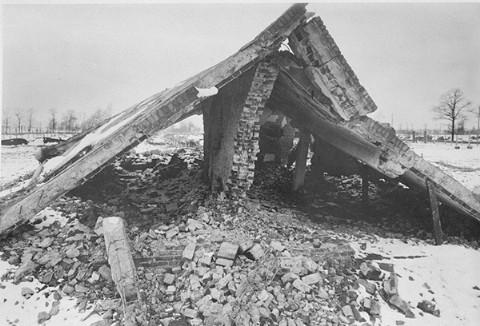 Why is it that the earliest photo that exists of the destroyed Crema II is this one from February 1945? Why is there no photograph from the time the Russians arrived in January, since such a picture would have much greater propaganda value? To properly document such an important discovery—that the Germans had blown up evidence of crimes as they retreated—many photographs would need to be taken. What happened? Did they run out of film?
Why is it that the earliest photo that exists of the destroyed Crema II is this one from February 1945? Why is there no photograph from the time the Russians arrived in January, since such a picture would have much greater propaganda value? To properly document such an important discovery—that the Germans had blown up evidence of crimes as they retreated—many photographs would need to be taken. What happened? Did they run out of film?
As Tom Moran noted on the Nizkor page linked to above: “It is written the Soviets installed an “Extraordinary Commission” the very day of liberation of the camp and yet no photos are presented on the Holocaust promotional circuit of these buildings, or what was left, lest of course the one and only photograph of Crema II which is nothing more than a collapsed slab of concrete.”
In Photographing the Holocaust: Interpretations of the Evidence (Tauris & Company, London, in association with The European Jewish Publication Society, 2004) on page 143, author Janina Struk writes:
On 28 January, 1945, the day after the camp was liberated by the Red Army, Adolf Forbert was one of the first Polish soldiers to arrive. He described his first impression of Auschwitz as being as “macabre” as Majdanek but on a larger scale.
Forbert stayed to film everything he could, but with only 300 meters of film, a camera of the Bell and Howell type manufactured by the Russians, and one Leica, the possibilities were limited.
He said there were 500 sick women in the women’s hospital in Birkenau. The fate of Forbert’s film and photographs of Auschwitz is not known.
The film “Chronicles of the Liberation of Auschwitz,” made in 1945, is attributed to four Soviet army filmmakers. The majority of the now well-known stills of the liberation are taken from this film.
Soon after liberation, other photographers began to arrive to take photos for the special investigative commissions established to collect evidence of Nazi crimes.
(Barbie) Zelizer [author of books on the Holocaust and Media -cy] states there was an inconsistency in the way the Soviets reported the liberation of the camps in Eastern Europe generally. Not only did they not publicize the liberation of Auschwitz until after the liberation of the western camps, but they didn’t issue press releases about the extermination camps at Belzec, Sorbibor and Treblinka.
Although their [Red Army] advances through Silesia were reported in detail, there were only two brief mentions about the liberation of the camp. On 29 January in the Guardian, one sentence. On 3 February, the Daily Express had one column on page 4 about the liberation.
In Poland itself, few images were published of the liberation of Majdanek or Auschwitz-Birkenau.
It would be decades before images of Auschwitz would become familiar in the West.
There is almost nothing in Holocaust literature on the arrival of the Soviets to Auschwitz-Birkenau. The only documentation was put together afterward. All the photographs that are exhibited in the various memorial museums (USHMM, Yad Vashem, A-B Memorial & Museum, etc.) and in books, are “stills” from a propaganda film(s) made many weeks or months later … or they are retouched photos, photo-montages and mis-labeled photos that actually show other places and even other national-ethnic groups.
The narrative of a January 27th liberation comes unraveled when scrutinized
Why all the deception? Why all the trickery? The arrival of the Soviets on Jan. 20 instead of Jan. 27 explains it. The person who runs Scrapbookpages Blog and calls himself “furtherglory” once wrote this to a commenter on his blog:
I have read in several books that the Soviets arrived in the area on January 17, 1945 and were in the area for 10 days before they “liberated” the prisoners on January 27, 1945. I have read at least one Holocaust survivor book which said that the warehouses were still there after the Germans left on January 18, 1945. I believe that the Soviets burned down the warehouses. With all the evidence gone, no one could dispute the Soviet testimony at the Nuremberg IMT that 4 million people had been killed at Auschwitz.
The Central Sauna building at Birkenau was kept off limits to tourists for 60 years. Why? The Sauna building was where the clothes were disinfected. Why weren’t tourists allowed to know that the Germans were trying to prevent typhus epidemics?
Also, keep in mind that the last group of Sonderkommandos were marched out of the Birkenau camp and I think a couple of them are still living. Why did the Germans allow these witnesses to live?
Cremas IV and V were also shower houses with hygiene facilities for disinfection. They were close to The Central Sauna and served the same purpose although on a smaller scale. Consider that if the only shower facility in the entire camp was the rather modestly-sized one in The Sauna building, it would not have been at all adequate. But with “Cremas IV and V” also serving that function, they got by. Crema IV was heavily damaged in an uprising on Oct. 7, 1944. Both were ultimately totally destroyed, but the question remains—by whom?
The answer has to be by the Russians themselves. And it is Elie Wiesel who has told us. Just as with his failure to mention “gas chambers” in his book Night, Wiesel falls out of step with the official storyline at times and lets the truth slip out. Was he just saying what most people knew at the time, in spite of what was dreamed up at Nuremberg? I think so. He wrote this in 1954. Not even Elie Wiesel should confuse 9 days with 2 days when it comes to a matter of life or death. Which brings up another question: Is it reasonable that the prisoners left behind in an unguarded facility would just hang around for nine days waiting for the feared “Red Army” to arrive? Would they not take off once they got the chance? Elie says he was one of the hospital patients, his father being allowed to stay with him, yet they both were capable of going on the evacuation march and keeping up with the pace. Thus, many others lying around in the hospital surely could do the same. That is, unless the Soviet representatives surprised them by showing up already on the 20th, before they could prepare themselves to leave.
The story of the Auschwitz liberation is as cloudy as it gets. It has been told in emotion-wrenching photographs that were all staged by Soviet photographers and film makers in the following month of February and even March–every one of them–and by revengeful witnesses who were coached in what to say. As portions of the book by Janina Struk point out, time would pass before a final solution of what happened at Auschwitz could be cobbled together for public consumption by Soviet propagandists.
Little New in Wiesel’s Speech at Xavier; Robert Ransdell Gets Attention
Written on May 8, 2012 at 1:50 pm, by Carolyn
By Carolyn Yeager
 Reportedly “thousands of students” listened to Elie Wiesel on Sunday night, May 6, in the Cintas Center in Cincinnati as he intoned his usual theme: “We haven’t done enough; we still haven’t learned from the Holocaust.” [Right photo shows one section of the Cintas auditorium interior, which is home to the Xavier basketball team.]
Reportedly “thousands of students” listened to Elie Wiesel on Sunday night, May 6, in the Cintas Center in Cincinnati as he intoned his usual theme: “We haven’t done enough; we still haven’t learned from the Holocaust.” [Right photo shows one section of the Cintas auditorium interior, which is home to the Xavier basketball team.]
Who does he mean by “we”? Why, white western (European) man, of course. Not Jews. Nor any other non-whites. They are the ones dying “of famine or of disease or of violence.” As he said, “Every minute today, somewhere in this world a child dies” from one of these three causes, and he asked “How is that possible in a civilized society?”
Civilized? Is the world composed of civilized societies? Most of these deaths of children occur in areas of the world that are not civilized, but Wiesel expects western White societies to be and to feel responsible for what occurs there. This is just one of the dishonest manipulations of thought and speech he exhibits. If you examine his words in any speech you want to name, you discover the irrational element running through it. The guilt-tripping of Europeans. The identification of himself with the innocence of children. He places himself on the child’s side, against what he would call selfish and indifferent White people.
He very quickly brought up Nazi Germany as the perfect example of this, and again his faux incomprehension about “why.” He said of Nazi Germany, “To this day, I don’t understand it. Why the children?” He is lying about the children because certainly the National Socialist regime did NOT go after children. Thousands of children were liberated from the camps, including himself (according to his story) and they were in good health. Pictures of the “boys of Buchenwald” shortly after “liberation,” for example, show sturdy, normal-looking boys. The internment policy did include whole families by necessity; sometimes they could remain together in family camps and sometimes they were separated by sex into sections for men and women.
Wiesel’s general pattern is to lament the state of the world, followed by “Will the world every learn?” or “The world hasn’t yet learned the lesson of The Holocaust.” This makes the Jews the teachers and the overwhelming majority of us who are not Jews the poor students who won’t learn. Wiesel always presents us with the entire world’s ills and expects a solution for the entire world … something that is not a possibility in any event. In this, he reveals his utter lack of intellectual integrity, common-sense reasoning, and good faith.
Wiesel extracts sympathy for himself; talks about crying
After describing his family victimology for the umpteenth time, he did say one thing new! In recounting his rescue from the concentration camp by the US Army, he recalled that “We cried. We discovered for the first time that we could cry.”
Again, who is “we”? Wiesel always said that he felt nothing after his father died; that he shed no tears at the liberation either. “Our first act as free men was to throw ourselves onto the provisions.” (Night, p115) It was later, at the orphanage in France, that he began to feel again, he said in his memoir. But now he’s added a new twist — he cries at liberation. Wiesel goes directly from these touching sentiments to denouncing those who deny the “existence of the Holocaust,” which is more of his dishonest manipulation of speech. Those he calls “deniers” only deny the official narrative of the Holocaust as the Jews insist on it; they do not deny “the existence” of what actually happened to Jews under National Socialism. Big difference, but this difference is denied by the holy holocausters and Wiesel followers. Only their version is acceptable and all must follow it or be called deniers.
Holocaust Denial should be a crime!
Wiesel again calls for the criminalization of “holocaust denial” in the United States. He thinks because this narrative has become sacred to Jews, it should be an exception to the guarantee of freedom of speech that Americans enjoy, and have enjoyed from America’s founding. Think about this. Think about this! This kind of “we come first” attitude is why National Socialist Germany wanted to remove their Jews from the country.
Elie Wiesel is very bold. We must be bold in return. He may feel that at his advanced age he should put it all out there, and, with his untouchable reputation and the protection of the mass media, go for broke. He defended Israel too, as he always does, especially in its formation (in which he played a part), and said he “hopes” for peace—easy to say. Wiesel poses himself as a defender of children, even while Israeli policies kill Palestinian children without a care. Everyone knows this, but at this large gathering, with most students sitting in the cheap seats in the upper balconies, there is no way to shout a question at him.
Robert Ransdell considers his action a success
Ransdell has informed Elie Wiesel Cons The World that he is writing up his May 6 experience to post on the internet under his name, but he sent a long email describing what took place. Unfortunately, he was alone and there was no one to take photographs of him.
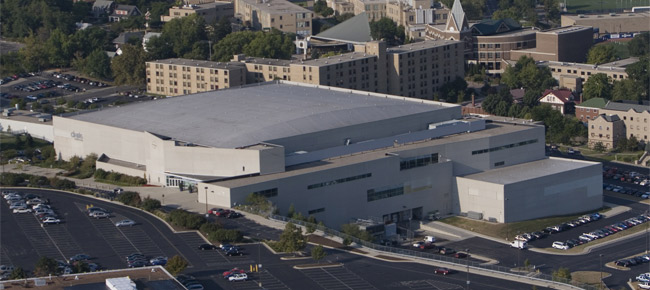 Cintas Center showing parking lot
Cintas Center showing parking lot
Upon arriving at the Cintas Center, he says he was already tailed by a motorcycle cop, who, however, did not accost him. After parking his car in the lot and walking a short distance toward the entrance, he was approached by two men in suits who identified themselves as campus police and told him he would not be admitted into the building. Hillel had done it’s job. They took his ticket and gave him a $20 bill to compensate for the cost. Ransdell was dressed in his custom t-shirt and hat which asked the question of Wiesel’s tattoo and stated the $1000 challenge.
Ransdell says he was prepared for this eventuality, so he left and parked across the street. He then stood on a street corner right in front of the main entrance to the Xavier campus where most of the people coming to the event would enter. It was still 45 minutes before 7 pm. He had brought with him a sign which was easily visible, and so he stood there with his sign, wearing his custom t-shirt and hat while the traffic flow built up until it was badly stalled first on one side and then the other, as each lane had to wait to turn into the entrance.
He says he was easily seen by the occupants in the cars since he received stares, visible gasps, sneers and middle fingers from them, while he smiled and waved. Some yelled words such as “bigot”at him, which is clearly the wrong word as he was asking to see a tattoo which Elie Wiesel has always said he has but which he has never shown. (Not to mention that photographs show it isn’t there.) Ransdell said some police were stationed across the street from him, which made him feel safer from the likelihood of someone getting out of a car and coming after him. So, all in all, Robert was a happy camper.
Critics and news blackout
He says he stayed until about 7:15 when traffic became completely normal again. Further details will be in Ransdell’s own written account. But I call him a courageous man for standing up to the power of the Jews in his own town as a known entity. He is a good-looking, well-spoken young man and while I would not have written the flyer exactly as he did, or put on the sign exactly what he did, I only find fault with those “couch quarterbacks” on CODOH Forum who criticize his actions from behind their pseudonyms. (Not all are critical.) If we had just a hundred Robert Ransdells, what an impact we could make. Why don’t we? Ransdell has allies but they are afraid to go to a public function with him! Another one who went out alone to a college campus with flyers about Elie Wiesel’s tattoo was Steve Bock, but these two live almost the entire width of the United States apart from each other.
The Channel 9 news truck was in the area, but made a point to ignore him — another example of the news black-out on any activity that is not good for Jews. They like controlled acts of “antisemitism” to feed their narrative, but do not like to have Elie Wiesel’s self-proclaimed tattoo brought into the limelight. That’s why we use it. It’s the most visible and effective counter to his story of himself as a holocaust survivor. Elie, please show us the tattoo!

